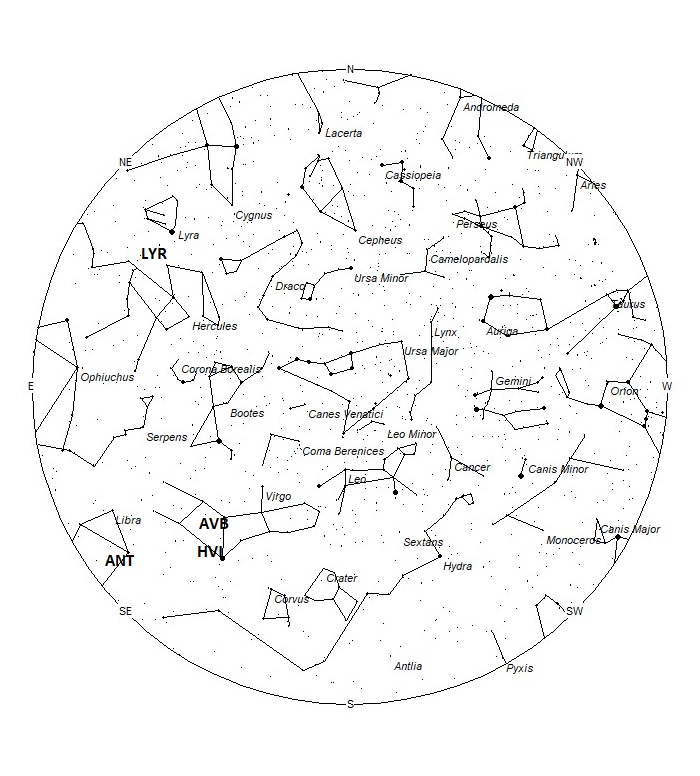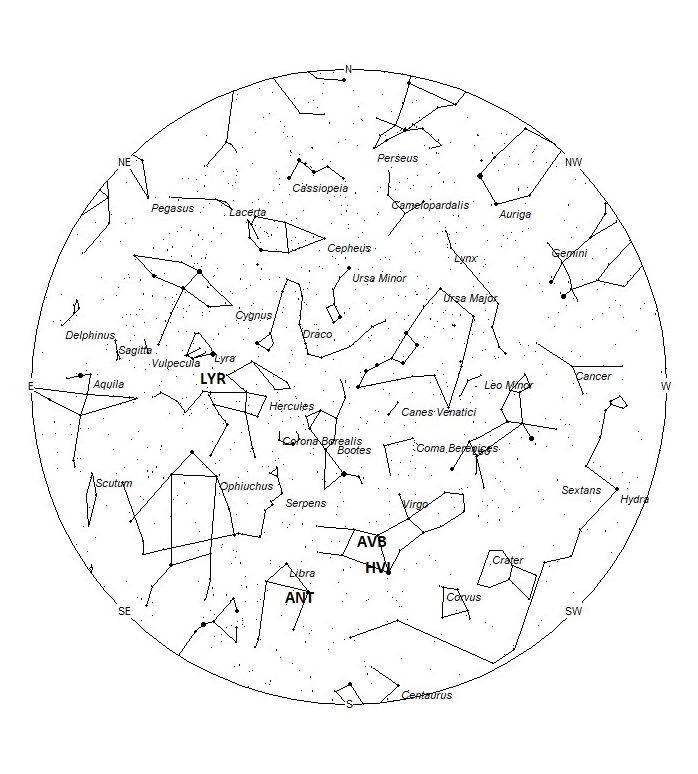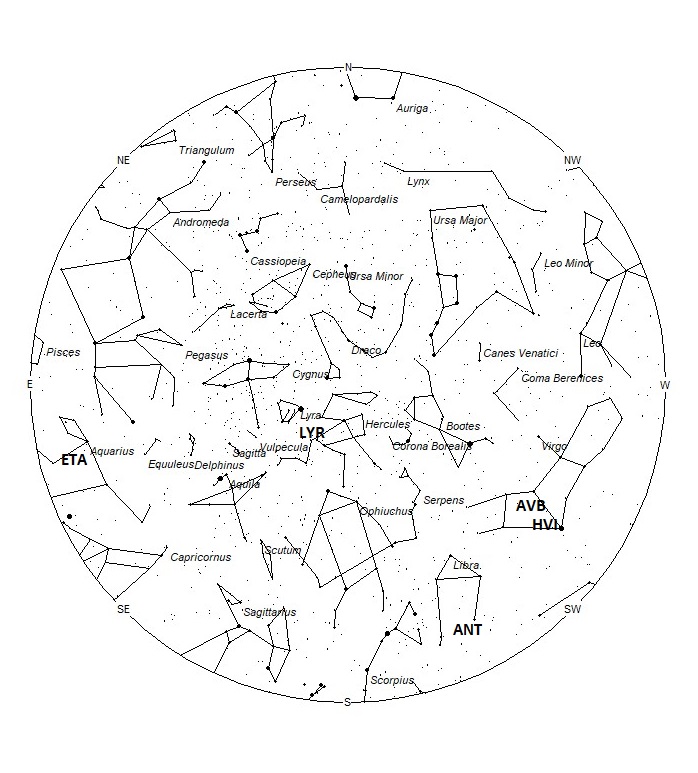During this period, the moon reaches its last quarter phase on Saturday April 23rd. On that morning the half-illuminated moon will rise between 3:00 and 4:00 local summer time (LST) and will interfere with morning meteor observations the remainder of the night. As the week progresses, the moon becomes less of a factor as its phase wanes and it rises closer to dawn. For evening observers, the estimated total hourly rates should be near 3 as seen from mid-northern latitudes (45N) and 4 as seen from tropical southern locations (25S) For morning observers, the estimated total hourly rates should be near 8 as seen from mid-northern latitudes (45N) and 12 as seen from tropical southern locations (25S). The actual rates will also depend on factors such as personal light and motion perception, local weather conditions, alertness, and experience in watching meteor activity. Morning rates are reduced during this period due to moonlight. Note that the hourly rates listed below are estimates as viewed from dark sky sites away from urban light sources. Observers viewing from urban areas will see less activity as only the brighter meteors will be visible from such locations.
The radiant (the area of the sky where meteors appear to shoot from) positions and rates listed below are exact for Saturday night/Sunday morning April 23/24. These positions do not change greatly day to day so the listed coordinates may be used during this entire period. Most star atlases (available at science stores and planetariums) will provide maps with grid lines of the celestial coordinates so that you may find out exactly where these positions are located in the sky. I have also included charts of the sky that display the radiant positions for evening, midnight, and morning. The center of each chart is the sky directly overhead at the appropriate hour. These charts are oriented for facing south but can be used for any direction by rotating the charts to the desired direction. A planisphere or computer planetarium program is also useful in showing the sky at any time of night on any date of the year. Activity from each radiant is best seen when it is positioned highest in the sky, either due north or south along the meridian, depending on your latitude. It must be remembered that meteor activity is rarely seen at the radiant position. Rather they shoot outwards from the radiant, so it is best to center your field of view so that the radiant lies at the edge and not the center. Viewing there will allow you to easily trace the path of each meteor back to the radiant (if it is a shower member) or in another direction if it is sporadic. Meteor activity is not seen from radiants that are located far below the horizon. The positions below are listed in a west to east manner in order of right ascension (celestial longitude). The positions listed first are located further west therefore are accessible earlier in the night while those listed further down the list rise later in the night.
These sources of meteoric activity are expected to be active this week.
.
The pi Puppids (PPU) are predicted to reach maximum activity on April 24th from a radiant located at 07:22 (110) -45. This area of the sky is located in central Puppis, 2 degrees south of the 3rd magnitude star known as sigma Puppis. This area of the sky is best seen as soon as it becomes dark. Rates are variable but expected to be less than 1 per hour no matter your location. These meteors are best seen from the far southern hemisphere where the radiant lies much higher in the sky compared to observers further north. With an entry velocity of 15 km/sec., the average meteor from this source would be of very slow velocity.
The h Virginids (HVI) were discovered by members of SonotaCo. These meteors are active from April 20-May 04 with maximum activity predicted on May 1st. The radiant is currently located at 13:28 (202) -10. This area of the sky is located in southern Virgo, 1 degree northeast of the 1st magnitude star known as Spica (alpha Virginis). This area of the sky is best seen near midnight local standard time (LST) when it is located highest in the sky. No matter your location, rates are expected to be less than 1 per hour. At 17km/sec. these meteors would produce meteors of very slow velocity.
The alpha Virginids (AVB) were first mentioned by R. B. Southworth and G. S. Hawkins in their publication known as Smithsonian Contributions to Astrophysics (1963). These meteors are active from April 6 though May 1 with maximum occurring on April 18th. The current location of this radiant is 13:39 (205) +04. This position is located in central Virgo, 3 degrees southeast of the 3rd magnitude star known as Heze (zeta Virginis A). This radiant is best placed near midnight (LST) when it lies on the meridian and is highest in the sky. Rates at this time should be less than 1 per hour no matter your location. With an entry velocity of 18 km/sec., the average meteor from this source would be of very slow velocity. This source is far enough from the h-Virginid radiant to be noticed but care must be taken to differentiate between the two radiants.
The large Anthelion (ANT) is currently centered at 15:04 (226) -17. This position lies in central Libra, 3 degrees southeast of the 4th magnitude star known as Zubenelgenubi (α² Librae). Due to the large size of this radiant, these meteors may also be seen from eastern Virgo as well as Libra. This radiant is best placed near 01:00 LST when it lies on the meridian and is highest in the sky. Rates at this time should be near 1 per hour as seen from the Northern Hemisphere and 2 as seen from south of the equator. With an entry velocity of 30 km/sec., the average Anthelion meteor would be of slow velocity.
The Lyrids (LYR) were predicted to reach maximum activity on April 22nd. Low rates from this source will continue for the remainder of the month. The radiant is currently located at 18:17 (274) +33. This area of the sky is located on the Lyra/Hercules border, 7 degrees southwest of the brilliant zero magnitude star known as Vega (alpha Lyrae). This radiant is best placed during the last hour before dawn when it lies highest above the horizon in a dark sky. Rate this weekend will be 1-2 per hour falling to less than one per hour as the week progresses. With an entry velocity of 47 km/sec., the average meteor from this source would be of medium-swift velocity.
The eta Aquariids (ETA) are currently active from a radiant located at 22:00 (330) -05. This area of the sky is located in northern Aquarius, 5 degrees south of the 3rd magnitude star known as Sadalmelik (alpha Aquarii). These meteors are not visible prior to 0200 LST and are best seen just before the start of dawn when the radiant lies highest in a dark sky. Hourly rates are expected to be low this week as maximum activity is still two weeks away. With an entry velocity of 65 km/sec., the average meteor from this source would be of swift velocity.
As seen from the mid-northern hemisphere (45N) one would expect to see approximately 4 sporadic meteors per hour during the last hour before dawn as seen from rural observing sites. Evening rates would be near 2 per hour. As seen from the tropical southern latitudes (25S), morning rates would be near 7 per hour as seen from rural observing sites and 3 per hour during the evening hours. Locations between these two extremes would see activity between the listed figures. During this period morning rates are reduced due to moonlight.
You can keep track of the activity of these meteor showers as well as those beyond the limits of visual observing by visiting the NASA Meteor Shower Portal available at: https://meteorshowers.seti.org/ You can move the sky globe to see different areas of the sky. Colored dots indicate shower meteors while white dots indicate sporadic (random) activity. The large orange disk indicates the position of the sun so little activity will be seen in that area of the sky.
The list below offers the information from above in tabular form. Rates and positions are exact for Saturday night/Sunday morning except where noted in the shower descriptions.
| SHOWER | DATE OF MAXIMUM ACTIVITY | CELESTIAL POSITION | ENTRY VELOCITY | CULMINATION | HOURLY RATE | CLASS |
| RA (RA in Deg.) DEC | Km/Sec | Local Summer Time | North-South | |||
| pi Puppids (PPU) | Apr 24 | 07:22 (110) -45 | 15 | 19:00 | <1 – <1 | III |
| h Virginids (HVI) | May 01 | 13:28 (202) -10 | 17 | 01:00 | <1 – <1 | IV |
| Alpha Virginids (AVB) | Apr 18 | 13:39 (205) +04 | 18 | 01:00 | <1 – <1 | IV |
| Anthelions (ANT) | – | 15:04 (226) -17 | 30 | 02:00 | 1 – 2 | II |
| Lyrids (LYR) | Apr 22 | 18:17 (274) +33 | 47 | 05:00 | 2 – 1 | I |
| eta Aquariids (ETA) | May 05 | 22:00 (330) -05 | 65 | 09:00 | 1 – 2 | I |




